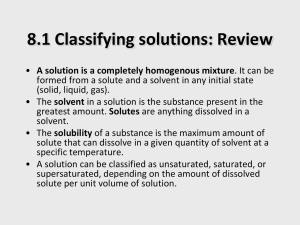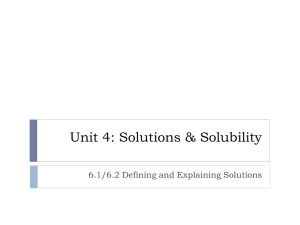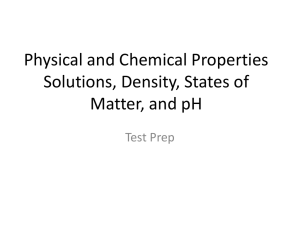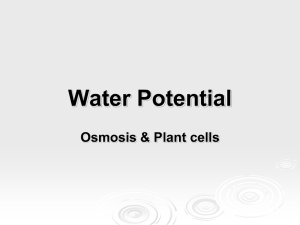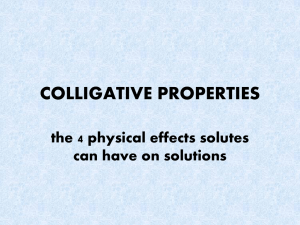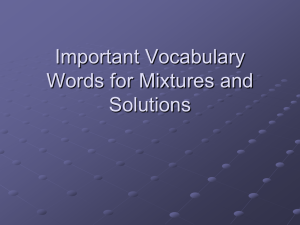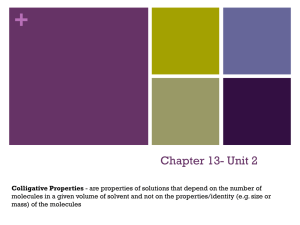Chapter 12
advertisement
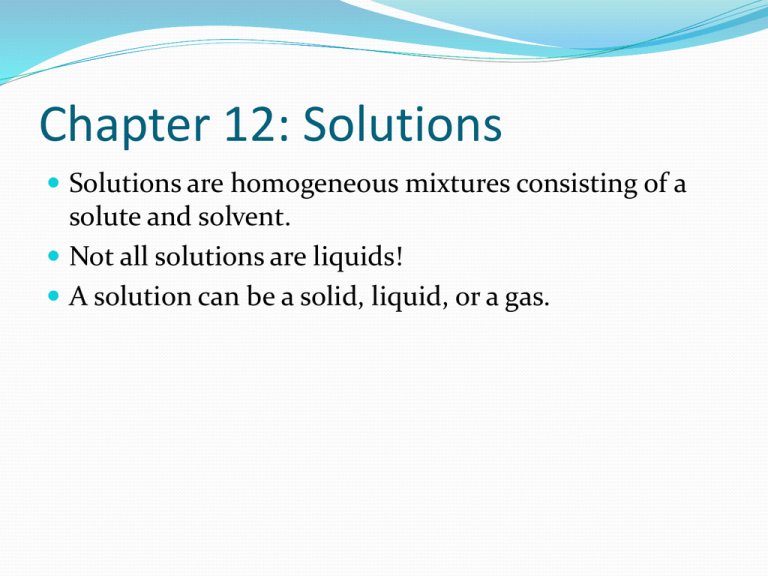
Chapter 12: Solutions Solutions are homogeneous mixtures consisting of a solute and solvent. Not all solutions are liquids! A solution can be a solid, liquid, or a gas. Types of Solutions Solution Process The intermolecular forces between solute and solvent particles must be strong enough to compete with those between solute particles and those between solvent particles. Solution Process As an ionic compound dissolves in water, the ions are surrounded by six water molecules. Solution Process Solution Process Energy of solution formation for ionic compounds has two factors. Factor One: Lattice energy of ionic compound. Factor Two: Ion-dipole force formed between water and ions. Which one requires energy? Which one produces energy? NH4NO3(s) and MgSO4(s) Ion-Dipole Force Intermolecular force between water and ion is called the Ion-Dipole force. Hydration energy = combined interactions of all six waters with the ion. Energy of Ionic Solutes DHsolution = DHhydration – DHlattice energy Insoluble Ionic Compounds Compounds with very LARGE lattice energies are insoluble. Compounds with smaller lattice energies are highly soluble. Ex) KBr(s) vs. PbS(s) Ex) Al2O3(s) vs. KNO3(s) Energy of Solution 1. Energy to overcome solute-solute interaction (requires energy = endothermic) 2. Energy to overcome solvent-solvent interaction (requires energy = endothermic) 3. Energy of solute-solvent interaction (produces energy = exothermic) Energy of Solution •If 1 + 2 – 3 > 0, then net process is endothermic. •If 1 + 2 – 3 < 0, then net process is exothermic. •If 1 + 2 – 3 >> 0, then the two substances will NOT mix. Spontaneity Enthalpy is not the sole factor in why things dissolve. Natural tendency of the universe is to go from order to disorder. A solution is going from order to disorder when mixing occurs. The amount of disorder is called the entropy of the system. Spontaneity Both CCl4 and C6H14 are non-polar molecules with similar boiling points. Adding the two together will produce a solution increasing the entropy of the system. Non-polar and Polar “Like dissolves like” Polar substances dissolve in polar solvents. Non-polar substances dissolve in non-polar solvents. Non-polar substances do NOT dissolve in polar solvents! Intermolecular Forces Types of Solvents Molecular Compounds Molecular compounds will dissolve in water IF they are polar or have hydrogen bonding. CH3CH2OH, CH3CHO Size, though matters! CH3CH2CH2CH2CH2CH2OH W14, #1 Vitamins Solubility of Alcohols Saturated Solutions When more solid solute is added to a liquid and the solid does NOT dissolve, the solution is said to be saturated. Solubility limit = maximum amount solute that can be dissolved in a given quantity of solvent. Ex) @25oC, KNO3 = 36g / 100mL. Super-saturated solution. Sodium Acetate Solution Temperature Effects The solubility limits of most solid solutes INCREASES with increasing temperature. Temperature Effects The solubility of ALL gases decreases with an increase in temperature. Can have an adverse reaction in ponds and lakes in the hot summer months. Concentrations 1. There are many methods for expressing concentration. Percent a. b. c. mass / mass volume / volume mass / volume Concentrations 2. ppm (106) or ppb (109) 3. Mole fraction = moles A / total moles 4. Molarity (M) – Chapter 4 5. Molality (m) Colligative Properties Why do we put “salt” on our roads in the winter? Why do we add “antifreeze” to the radiator in our cars? Can we reduce the vapor pressure of “volatile” liquids? Yes! Colligative Properties Any property that depends only on the quantity of solute particles and not their identity. Vapor Pressure lowering Freezing-pt depression Boiling-pt elevation Osmotic Pressure Vapor Pressure A non-volatile solute (solid) can be added to a volatile solvent and LOWER its vapor pressure. Pa = ca Pao Mole fraction is for the solvent and Pao is the vapor pressure for the pure solvent (dependent on T). Addition of a nonvolatile solute reduces the rate of vaporization, decreasing the amount of vapor Vapor Pressure Two volatile liquids, of similar intermolecular forces, will both contribute a partial pressure. Raoult’s Law Ptotal = caPao + cbPbo Graphical interpretation Fractional distillation Ideal vs. Non-ideal Behavior BP and FP When a solute is added to a solvent: the freezing-pt is lowered. the boiling-pt is raised. Formulas are similar: DT = Kf cm DT = Kb cm Osmosis In biological systems, the cellular walls are made up of cellulose. Cellulose allows water molecules to pass in and out of the cells. Larger molecules or ions are generally “blocked” from entering. Note: glucose is transported into the cells via a complex process. Osmosis When two solutions of different concentrations are separated by a semi-permeable membrane, solvent molecules will flow from lower solute concentration to higher solute concentration. Osmosis This is important in maintaining water in our cells. Osmotic Pressure The osmotic pressure is measured in atmospheres. p = MRT M is the molarity of the solution R = 0.08206 L atm/mol K T = temperature, K Molar Masses Many experiments involving colligative properties can find a molar mass of a solute. Generally, this requires us to work backwards through several formulas. Ionic Solutes Because ionic solutes break apart into ions, an adjustment to our formulas must be made. i = van’t Hoff factor. Equals the number of ions per formula unit. True factor depends on the concentration. As the concentration increases, i becomes less than predicted. Why? Ionic Solutes Ionic Solutes Assume “ideal” values for each electrolyte. Becomes multiplier in all formulas. What is i for: CaCl2 Na2CO3 Al(NO3)3 NH3 Colloids When larger solute particles remain suspended in a solution, they form a colloid. Colloids will exhibit the Tyndall Effect due to the larger particles. Colloids Tyndall effect in nature. Colloids There are several types of colloids. Aerosol = a liquid or solid in a gas. fog, smoke Foam = a gas in a liquid or solid. whipped cream, marshmallow Emulsion = a liquid in a liquid or a solid in a solid. milk, butter, mayo Sol = a solid in a liquid or solid. cement, paint, gems
